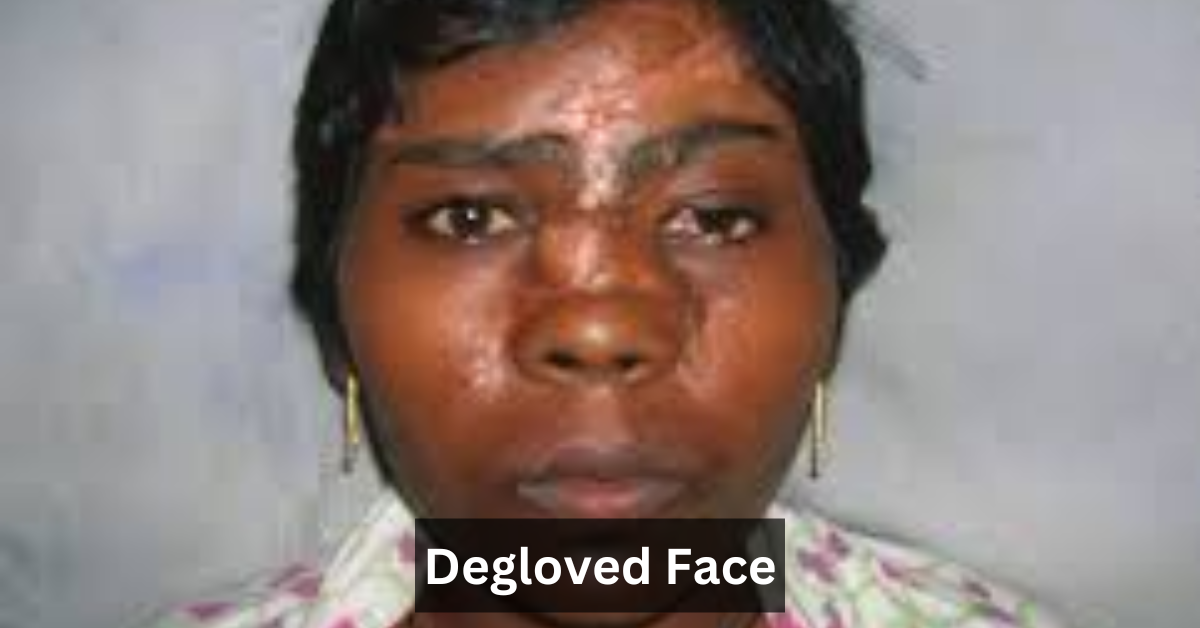A Degloved Face is one of the most extreme and traumatic injuries that can affect a human being. This condition occurs when the skin and underlying tissues of the face are forcibly separated from the bone structure, similar to removing a glove from a hand. Known medically as a facial degloving injury, this type of trauma not only causes visible disfigurement but can also impair vital functions such as breathing, vision, and speech. When a Degloved Face injury occurs, immediate intervention is necessary to save the person’s life and improve long-term outcomes. The condition is rare, but when it does happen—most often in high-speed vehicle accidents or industrial incidents—it requires highly specialized trauma and reconstructive care.
The World Health Organization (WHO) recognizes degloving injuries as critical emergencies, particularly when they affect the facial region. The American Association of Oral and Maxillofacial Surgeons (AAOMS) emphasizes the importance of quick surgical action, accurate diagnosis using CT scans or MRIs, and the coordination of multidisciplinary teams including plastic surgeons, reconstructive specialists, and emergency medical services (EMS). A Degloved Face is not just a skin injury; it’s a life-altering condition that affects both physical functionality and psychological well-being.
What Causes a Degloved Face?
High-Impact Accidents and Facial Trauma
The most common cause of a Degloved Face is high-speed vehicle collisions, especially motorcycle accidents. The sheer force of impact can result in the skin and soft tissue being peeled away from the underlying structures. In many maxillofacial trauma cases, victims are thrown from the vehicle or come into contact with sharp, unyielding surfaces, leading to severe facial skin avulsion and full-thickness injuries.
Industrial, Machinery, and Animal-Related Injuries
Workplace accidents involving heavy machinery also frequently result in face degloving surgery cases. If protective gear fails or is not worn, the rotating parts of machines can catch and tear facial skin. Rare but devastating cases of animal attacks have also led to Degloved Face injuries. These incidents often require microsurgical reattachment and skin graft surgery to repair extensive tissue damage.
Risk Factors and Vulnerable Demographics
Young men, often those engaged in high-risk activities or jobs, are statistically more prone to experiencing facial degloving. Motorcyclists without helmets, construction workers, and industrial laborers top the list of vulnerable groups. In areas without immediate trauma care, the outcome of a Degloved Face injury can be even more devastating.
The Anatomy Behind a Degloved Face
Layers of Skin and Tissue Affected
When a Degloved Face injury happens, it involves multiple layers of soft tissue being separated from the maxillofacial anatomy, including the dermis, fat, muscles, blood vessels, and nerves. Depending on the force and area of impact, the degloving may be partial or full, with partial face degloving involving a specific region like the cheek or chin, and full-face cases affecting the entire visage.
Facial Nerve and Vascular Involvement
One of the biggest challenges in treating a Degloved Face is preserving or restoring the facial nerve (CN VII), which controls facial expressions. Damage to this nerve can lead to permanent paralysis of facial muscles. Similarly, blood vessels that supply the face may be severed, causing significant bleeding and increasing the risk of tissue necrosis if blood flow is not restored quickly.
Recognizing Symptoms and Immediate Complications
Visible Signs and Trauma Indicators
The most alarming sign of a Degloved Face is the visible separation of skin from the bone, often with skin hanging loosely or completely detached. Victims may experience severe bleeding, loss of sensation in affected areas, and obvious disfigurement. The psychological shock of seeing one’s own face in such a state often contributes to post-traumatic stress.
Bleeding, Infection, and Shock
Due to the dense network of vessels in the face, blood loss can be rapid and life-threatening. Immediate stabilization is crucial. In the absence of proper wound management, the open areas can become infected, requiring aggressive antibiotic treatment and critical wound care procedures. Patients may also enter hypovolemic shock, necessitating urgent transfusions and resuscitation.
How Is a Degloved Face Diagnosed?
Emergency Medical Services (EMS) and Triage
EMS teams are trained to identify the signs of a Degloved Face during trauma assessments. Their goal is to stabilize the airway, control bleeding, and transport the patient to a Trauma Level 1 Center where advanced diagnostics and surgical care are available.
Role of Imaging – CT Scan and MRI
Upon arrival at the hospital, a CT scan or MRI is usually performed to assess the full extent of soft tissue and skeletal damage. These imaging tools help the surgical team plan for emergency facial reconstruction and identify any hidden injuries that may affect surgical outcomes.
Surgical Management and Treatment Options
Primary Closure and Debridement
The first stage in managing a Degloved Face is primary wound closure, which involves realigning torn tissue and suturing it in place if viable. Necrotic or non-salvageable tissue is removed through debridement, minimizing the risk of infection.
Skin Grafting and Microsurgery
When the original tissue cannot be saved, surgeons use autografts (from the patient) or allografts (donor skin) to restore facial coverage. Microsurgical reattachment is often employed to reconnect blood vessels and nerves. Complex cases may require flap reconstruction, a technique where tissue from another part of the body is transplanted to the face with its blood supply intact.
Advancements in Tissue Engineering
Innovations in tissue engineering now allow for synthetic and bioengineered materials to be used in reconstructive efforts. These materials reduce the risk of graft rejection and help restore facial contours more naturally. ISAPS and Harvard Medical School have published groundbreaking studies showcasing the future of regenerative options for facial disfigurement solutions.
Post-Surgery Rehabilitation and Recovery
Wound Care and Pain Management
Following surgery, wound sites must be closely monitored. Patients typically require regular dressing changes, pain management, and antibiotics. Maintaining hygiene is essential to prevent infection and promote healthy tissue integration.
Nerve Repair and Facial Movement Restoration
Some patients with a Degloved Face experience long-term or permanent nerve damage. Facial nerve repair may involve secondary surgeries or therapeutic interventions to regain muscle control. Physical therapy plays a vital role in restoring facial symmetry and movement.
Psychological Counseling and Emotional Healing
Beyond the physical toll, recovering from a Degloved Face injury requires intensive emotional support. Psychological counseling services help patients cope with the trauma, depression, or anxiety that may follow. Support groups and reconstructive outcomes offer emotional relief and a sense of hope.
Real-Life Cases and Success Stories
Notable Facial Degloving Cases
Case studies from institutions like Johns Hopkins Trauma Center have highlighted the successful recovery of patients suffering from accident-degloved injuries. Some individuals, after undergoing multiple stages of facial reconstruction after degloving, regained both function and near-normal appearance.
Hope Through Modern Medicine
Thanks to plastic surgery for trauma, many victims have reclaimed their lives. These stories emphasize the importance of timely intervention, skilled surgical teams, and patient resilience. From motorcycle degloving accidents to industrial trauma, the road to recovery—though challenging—is filled with possibility.
Life After a Degloved Face Injury
Living With Scarring and Disfigurement
While many patients recover, some may live with visible scars or altered facial features. However, cosmetic reconstruction techniques such as dermabrasion, laser treatment, and advanced implants offer improved aesthetics over time.
Reintegration, Confidence, and Mental Health
Rebuilding self-confidence after a Degloved Face injury is a gradual process. Community support, ongoing therapy, and reconstructive follow-ups can significantly enhance quality of life. It’s not just about looking whole again, but feeling whole.
Conclusion
A Degloved Face injury may appear catastrophic, but with early intervention, world-class surgical expertise, and holistic care, recovery is entirely possible. Teams at Trauma Level 1 Centers, backed by institutions like Harvard Medical School and supported by organizations such as AAOMS and ISAPS, are pioneering new ways to restore lives.
To patients and families facing the unimaginable, know this: modern medicine is a beacon of hope. From degloving wound management to full facial trauma recovery, the road is difficult but filled with promise. You are not alone, and healing—inside and out—is always within reach.
Frequently Asked Questions
Can a Degloved Face be fully repaired?
In many cases, yes. With advanced maxillofacial reconstructive surgery, tissue grafts, and microsurgery, a Degloved Face can often be repaired to restore both form and function.
What are the survival chances?
Survival largely depends on the severity of the injury, the speed of medical response, and the presence of other trauma. Immediate care significantly boosts survival rates.
How long does recovery take?
Recovery timelines vary but typically range from several months to over a year, including multiple surgeries and therapies.
Does insurance cover facial degloving surgery?
Yes, most health insurance plans cover surgeries related to trauma, including face degloving surgery, especially when performed in emergency contexts.
Are there non-surgical treatments?
While surgery is the cornerstone of treatment, physical therapy, counseling, and cosmetic treatments play vital roles in the complete recovery journey.
Stay in touch to get more updates & alerts on Erome! Thank you



